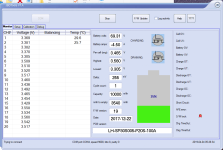stevecahill
10 W
- Joined
- Jan 28, 2019
- Messages
- 79
Just got my AliExpress Bluetooth BMS up and running with the VMBS app. All seems to work well. Does anyone know if firmware will support readouts in F vers C degrees?
that is some massive inbalance, so not all is well... :wink:evblazer said:Thank you that was it. At first I didn’t have it hooked up. Then I mistakenly had C- hooked up to the battery and B- hookednto the charger. I fixed that after rechecking everything again and all is well.
nobody in the civilized world uses F so unless someone from Liberia or the bahama's writes a new program i dont see that happening real fast.stevecahill said:Just got my AliExpress Bluetooth BMS up and running with the VMBS app. All seems to work well. Does anyone know if firmware will support readouts in F vers C degrees?
nobody in the civilized world uses F so unless someone from Liberia or the bahama's writes a new program i dont see that happening real fast
pretty sure the local "pharmaceutical supplier" uses metric. as does everyone in any serious field.stevecahill said:Sorry, FYI. The US never adopted the metric system. So Fahrenheit is used in the US and all weather temp reports are in Fahrenheit.
topcat36 said:Hello everyone.
I have a smartBMS 24s from Igogogo store. Did anyone analyze the communication protocol between the BMS and LCD ? The 4 communication wires resemble a serial connection (GND, Rx,Tx,VCC).
I want to obtain the working parameters for my own project and I want to leave the Bluetooth connection free for configuration purposes.
Wow. Just googled it: (c) Wikipedianobody in the civilized world uses F so unless someone from Liberia or the bahama's writes a new program i dont see that happening real fast.
Bazz0847 said:The newest version works as a charm! Superthanks!
Where did you get that one?

Mormegil83 said:Thank you, flippy! I've found your comments and advice very useful throughout this thread, and you have basically confirmed what I suspected regarding the TC Elcon CAN charger, and regarding the Chinese BMS models discussed here.
As for new cells... I originally was going to do a less powerful build on a shoe string budget when I started the initial brainstorm last March, and quickly learned a big battery for anything more than a bicycle will be the most expensive single component of the build. I work for a large healthcare company and hit up some friends from IT for any laptop batteries being disposed. Then I started hitting up big box home improvement and electronic stores if they allowed me to dig through their battery recycle bins. So free cells are a big cost savings. I've very patient and vigilant and have been able to find many other components for great deals. Motorcycle frame with title $20, Alltrax controller $250, perm motor $275, it's coming down to the nitty gritty of the energy charging and storage components that I'm having trouble sourcing used or cheap, but all I need to bolt everything together really is the charging solution and whatever components I need for the battery to work with the charger (CAN BMS or whatever I end up with.) I should have enough cells to get to and from work ,20miles round trip/back road speeds, but would really prefer a descent on board charger. So I don't make a mistake and not have enough juice to get back home lol! I'm just really having a hard time finding details on chargers and CAN in general and BMS (present thread excluded!)
If anyone has suggestions for a cost effective CAN BMS that can peak 450a please dm me, or if there is another way to communicate to the TC Elcon CAN, or if there is another good on board charging solution that will charge a 72v 30-50ah battery made of old laptop 18650 cells. I'll probably start a new thread to pose this question. So we can stay on topic here.
